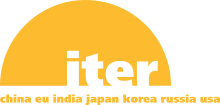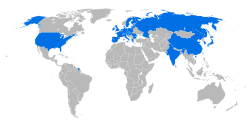International Thermonuclear Experimental Reactor
 |
|

Thirty-five participating nations
|
|
| Motto | The way to new energy |
|---|---|
| Formation | 24 October 2007 |
| Headquarters | Saint-Paul-lès-Durance, France |
|
Director-General
|
Bernard Bigot |
| Website | www |
 |
|
| Type | Tokamak |
|---|---|
| Construction date | 2013–2019 |
| Major radius | 6.2 m |
| Plasma volume | 840 m3 |
| Magnetic field | 11.8 T (peak toroidal field on coil) 5.3 T (toroidal field on axis) 6 T (peak poloidal field on coil) |
| Heating | 50 MW |
| Fusion power | 500 MW |
| Continuous operation | up to 1000 s |
| Location |
Saint-Paul- lès-Durance, France |
Coordinates: 43°42′17.84″N 5°46′9.1″E / 43.7049556°N 5.769194°E
ITER (Latin for "the way", formerly International Thermonuclear Experimental Reactor) is an international nuclear fusion research and engineering megaproject, which will be the world's largest magnetic confinement plasma physics experiment. It is an experimental tokamak nuclear fusion reactor that is being built next to the Cadarache facility in Saint-Paul-lès-Durance, which is in southern France.
The ITER project aims to make the long-awaited transition from experimental studies of plasma physics to full-scale electricity-producing fusion power stations. The ITER fusion reactor has been designed to produce 500 megawatts of output power for around twenty minutes while needing 50 megawatts to operate. Thereby the machine aims to demonstrate the principle of producing more energy from the fusion process than is used to initiate it, something that has not yet been achieved in any fusion reactor.
The project is funded and run by seven member entities—the European Union, India, Japan, China, Russia, South Korea, and the United States. The EU, as host party for the ITER complex, is contributing about 45 percent of the cost, with the other six parties contributing approximately 9 percent each.
...
Wikipedia
